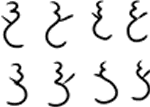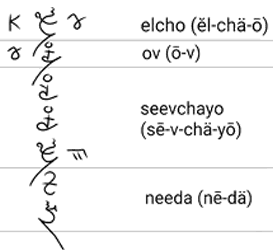
Elithnah is a script created for the novel Lost Blood by Richard Orbeck. It is used to write Dadeirom b'Vae ("the Tongue of Vae"), the constructed language that features in the book.

The syllabograms were adapted from an earlier form of pictographs, with animal figures representing the vowel syllables and human figures representing the consonants. Many of these are still recognizable. The consonants still have distinct parts: heads, arms, and legs. These parts can be mirrored individually without changing the meaning of the symbol. This is done purely for artistic purposes or to make the act of writing flow easier, however the variety this adds can make the script appear to have many more characters than is strictly true.
For example, all eight of the following characters are acceptable forms of (rä).

Note that each has a "3" shaped "head," a single diagonal line for an "arm," and a large hooking curve for its "legs." The orientation of each component doesn't matter so long as each is present. Such modification is never used for vowel characters.
Words are constructed by arranging syllabograms into columns read from top to bottom.
Simplified vowels are never used in line with the other syllabograms in the column. Instead they are placed either to the left of a Consonant character they precede or to the right of a Consonant character that they follow. However the simplified vowel characters are never used next to a formal Vowel character. Barring this, the decision to use a formal vs simplified vowel is up to the writer, as is the decision whether to place the simplified vowel next to its preceding or following consonant.
For example, the word for "cedar tree" is wahkirdahai, comprised of the syllables wä-kï-ïr-dä-hī. The order of consonants (C) and vowels (V) is CCVCV. Using different combinations of formal and simple vowels, there are six possible arrangements for this word.

Using different orientations for the consonants as stated above together with these options there are a total of 1536 distinct ways to write wahkirdahai.
While it is possible to eschew filling the left or right positions as shown above and use only formal variants of vowel characters throughout an entire word, such a style is, perhaps counter-intuitively, considered rude and denotes the author patronizing or "speaking down" to the reader. Favoring the right position when another arrangement is possible is considered a highly formal mode of writing (either an inferior addressing a superior or a superior informing subordinates) or used to emphasize the importance of certain words, such as with names or proper nouns.
The end of a word is marked by a terminal "tail" from the last character in the center position. This tail is pointed down and to the left. Note that it may not always be the last syllogram that appears in the word since a word ending in a consonant-vowel combination could place the last vowel in the right position next to the consonant.
The end of a sentence is marked by a tail that falls to the right in lieu of the usual word-terminal tail.
The sentence "The child has a destiny." translates Elcho ov seevchayo needa. (The child / a / destiny/ has.)

Questions are denoted by a reverse tail on the first (center position) character of the sentence. This tail rises up and to the left, making it run parallel to any preceding sentence-terminal mark.
While not strictly punctuation, words sometimes use unique prefix and suffix syllables. In the written word these unique syllables are made by modified forms of closely related characters with specific rules for placement and arrangement within the word. While these special characters carry their own syllable and are spoken aloud, their usage may be considered a type of punctuation.
Verbs are made past tense or future tense by the addition of a modified character as a suffix.
In the spoken language these suffixes can change the pronunciation of the verb beyond the simple addition of the syllable suffix, however in writing the spelling of the base verb is otherwise unchanged. Note that the suffix character itself is used as a substitute for the terminal tail. Whenever these are used no simplified vowel can be placed in the left or right positions to the suffix, and so the arrangement of the preceding characters must support this.
Elithnah makes uncommonly heavy use of collective nouns. Despite this some nouns still retain a plural form and use the prefix (lăl-). This is written as a double (ĕl) using the simple form combined into a single character and always placed in the left position at the beginning of the word. A rising-tail mark in the case of a question still stems from the first center position character of the word.
The prefix (bū-) makes a noun possessive. In writing this is made by a variant form of (bw). While normally a simplified vowel can be placed on either side of the center position, when used to indicate the (bu-) prefix the positions to either side are left empty. The single exception to this is (lăl-) when writing a possessive plural, spoken as lăl-bū-.
The simple forms of vowel syllabograms have associated numbers and are used in a manner similar to Roman numerals. These are arranged in a single column read top to bottom and accompanied by a vertical line to the left of the characters. A break in the line denotes the end of one number and the beginning of another.

Omrah lalwai'ur ror'rahnah elne deetat vayama-veem elne laldachav va'or. Ormah vayirchel-oryah elne waray-oryah daeriyahgi elne darrel vraywai-vrayel bumahyah'oir vrivari-veem ma'or deevay.
All human beings are born free and equal in dignity and rights. They are endowed with reason and conscience and should act towards one another in a spirit of brotherhood.
(Article 1 of the Universal Declaration of Human Rights)
Constructed scripts for: Ainu | Arabic | Chinese languages | Dutch | English | Hawaiian | Hungarian | Japanese | Korean | Lingala | Malay & Indonesian | Persian | Tagalog / Filipino | Russian | Sanskrit | Spanish | Taino | Turkish | Vietnamese | Welsh | Other natural languages | Colour-based scripts | Tactile scripts | Phonetic/universal scripts | Constructed scripts for constructed languages | Adaptations of existing alphabets | Fictional alphabets | Magical alphabets | A-Z index | How to submit a constructed script
[top]
You can support this site by Buying Me A Coffee, and if you like what you see on this page, you can use the buttons below to share it with people you know.

If you like this site and find it useful, you can support it by making a donation via PayPal or Patreon, or by contributing in other ways. Omniglot is how I make my living.
Note: all links on this site to Amazon.com, Amazon.co.uk
and Amazon.fr
are affiliate links. This means I earn a commission if you click on any of them and buy something. So by clicking on these links you can help to support this site.
[top]